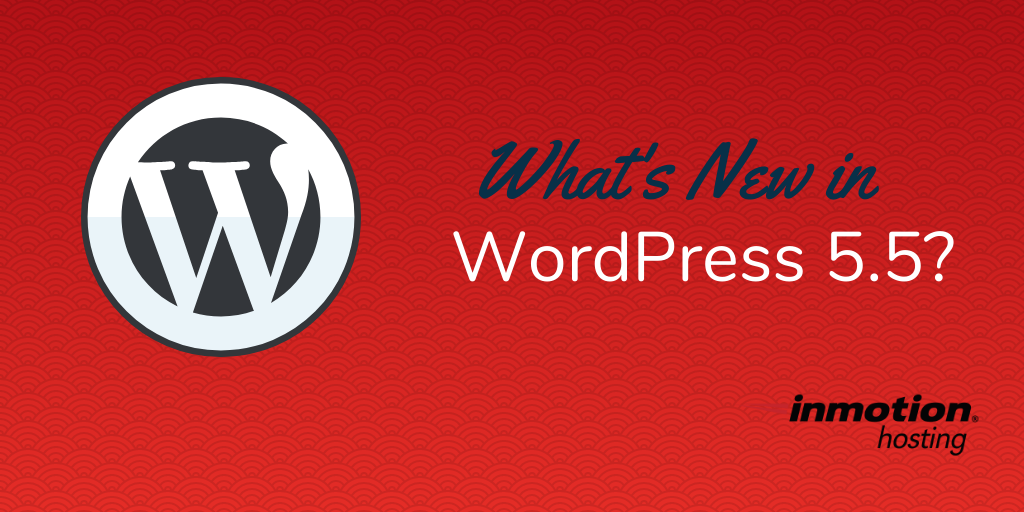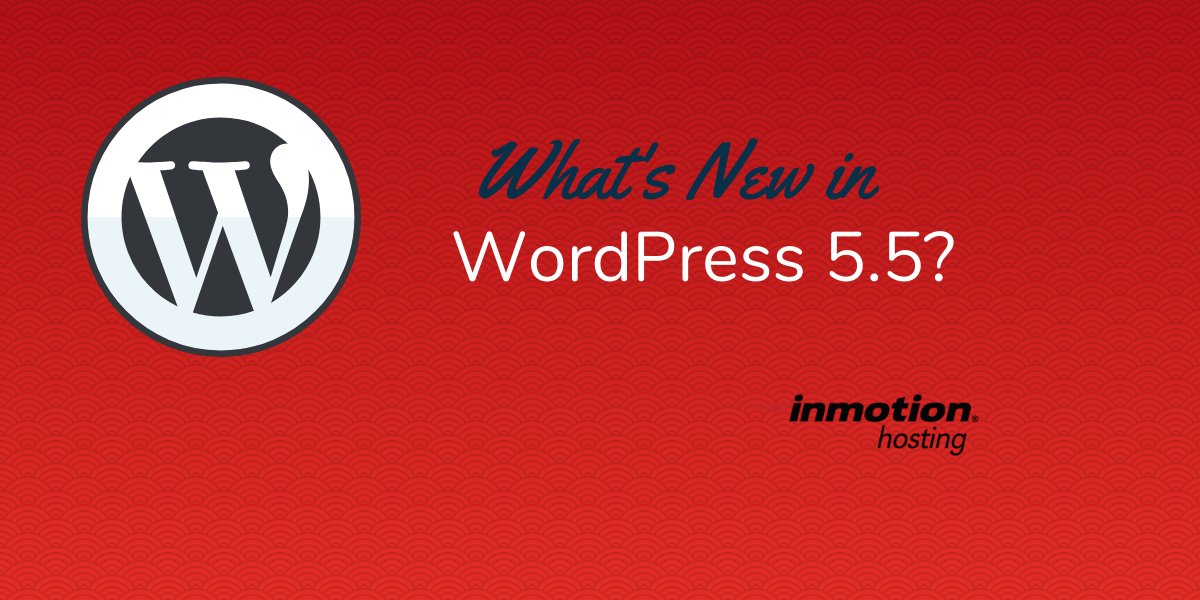Table of Contents

WordPress 5.5.1 Maintenance Release
WordPress 5.5.1 was released on September 1, 2020, and was the first maintenance release for WordPress 5.5 featuring 34 bug fixes and five enhancements, including five bug fixes for the blocks editor.
The major bugs fixed with WordPress 5.5.1 were:
- Cannot attribute content when deleting users
- Bottom “Bulk actions” dropdown menu doesn’t work when editing posts
- Scripts loaded through concatenation don’t print their translations
- Block Editor: Update WordPress Packages WordPress 5.5.1
A full list of WordPress 5.5.1 Maintenance Release bug fixes and enhancements can be found here.
Introducing WordPress 5.5
WordPress 5.5 is here, and while there is no new default theme introduced in this release, 5.5 brings with it some big updates and plenty of helpful new features.
Released on August 11, WordPress 5.5 was the second major release of 2020 and continues to enhance the Gutenberg block editor that was introduced with WordPress 5.0.
It is the 38th major release in WordPress’s 17-year history.
Enjoy fast, secure hosting optimized for your WordPress website with our WordPress Hosting plans.
Gutenberg Gets a Boost
The latest version of WordPress includes 10 releases of the Gutenberg block editor, introducing several improvements to the world’s top content management system (CMS).
The overall look has been upgraded with new borders outlining buttons and toolbars, focus highlighting that indicates movement across blocks when writing, and the addition of new icons.
Enjoy fast, secure hosting optimized for your WordPress website with our WordPress Hosting plans.
Inline Image Editing
One of the most helpful new features introduced in WordPress 5.5 is the inline image editor. Editing images is easier than ever now with the ability to scale, crop, rotate, and resize images directly from image blocks, meaning users don’t have to go to their media library to edit photos anymore.
Improved Block Movement and Navigation
Moving and editing blocks will also be easier in WordPress 5.5, which features a refined drag-and-drop tool. With block movers you can now see and grab, rearranging blocks in the content editor is now as simple as clicking on a block handle and moving it up or down.
This version also introduces the ability to copy and relocate blocks easily, and with new multi-select formatting, users can change a group of blocks at once.
Block Patterns
Users will be able to build beautiful pages faster and easier than ever thanks to the new block patterns feature. There are several default patterns currently available, and adding them to your pages only takes a few clicks.
The block patterns feature will also allow theme authors to shine. Instead of having to find a way to explain to users how to recreate their themes, theme authors can now register their creations as a pattern to make it easily available to end users for use on their sites.
All New Block Directory
WordPress 5.5 will introduce an all new block directory, which is essentially a marketplace for plugins that add new blocks to the block editor that allows users to discover, install, and insert third-party blocks directly into their WordPress website.
There’s a handful of plugins available already, with more to come as the block directory continues to grow.
A notable feature of this new tool is the ability to search by feature in the “Add New Block” search bar, and WordPress will automatically find any matching results in the block directory.
Device Previews
It can be really frustrating to get everything organized on your WordPress website, only to find out it looks terrible on another device.
WordPress 5.5 eliminates the guesswork or formatting your site for different devices with the device preview option. Now, instead of saving your site and testing it on different devices, users can use the device preview option to easily see how content will look to users on a range of different screen sizes.
You can further customize this with the UserAgent Content Switcher plugin.
Built-in XML Sitemaps
An XML sitemap file helps Google, DuckDuckGo, and other major search engines better understand your website while crawling it. It ensures they find all of your web pages that they might otherwise miss when indexing.
XML sitemaps play a big part in your search engine optimization (SEO) set up, and until now, users typically relied on SEO plugins such as BoldGrid SEO and All in One SEO to index their content.
WordPress 5.5 can eliminate the need for some SEO plugins. Having XML sitemaps enabled by default makes homepages, posts pages, core post types (pages and posts), custom post types, core taxonomies (tags and categories), custom taxonomies, and users (authors) indexable.
That means WordPress will automatically create a new sitemap index file called wp-sitemap.xml for your site which will contain links to all other sitemap files it generates.
There is also an API shipping with the XML Sitemaps plugin designed with the intent for developers to expand upon it.
While WordPress 5.5 is able to produce sitemaps on its own, more advanced users or those who already use SEO plugins for sitemaps may want to continue to do so as the third party plugins often offer greater sitemap customization options.
Auto Updates for Themes and Plugins
For users who hate having to remember to update their plugins or themes, WordPress 5.5 has a gift for you.
Within WordPress 5.5, auto updates can now be enabled through the WordPress dashboard for both WordPress themes and plugins, eliminating the need to manually check for updates or configure auto-updates in your wp-config.php files. Enabling auto-updates is as simple as checking any other box in the WordPress dashboard.
WordPress recommends that you always keep your themes and plugins up-to-date, making this a useful feature that allows you to set up auto updates and forget about it.
Whenever in doubt about making updates, create a cPanel backup first.
Lazy Loading for Images
Image-heavy pages tend to increase the time it takes to load a page, so optimizing images for your website is a great way to improve your page load time. Some use plugins such as EWWW Image Optimizer to achieve this.
One of the most popular ways to do so is to set images to lazy load. Whereas eager loading loads all the photos on a page at once, lazy loading only loads images in a visitor’s immediate view, increasing the speed at which they load.
Until now, users would have to install a third party plugin to lazy load images, but thanks to WordPress 5.5, lazy loading can now be added to any page by adding the “loading” attribute to any “img” tag.
This should speed up millions of websites on the internet while saving them bandwidth in the process, and benefit those who might not have the best internet connection.
WordPress 5.5 Release Notes
Hopefully this article has helped you prepare for the upcoming August 11 release of WordPress 5.5.
If you just can’t wait until then to get your hands on it, you can try out the beta version of WordPress 5.5 now by downloading the WordPress Beta Tester.
WordPress is constantly evolving! Stay up to date with the latest WordPress news and releases to keep your website modern and secure!


